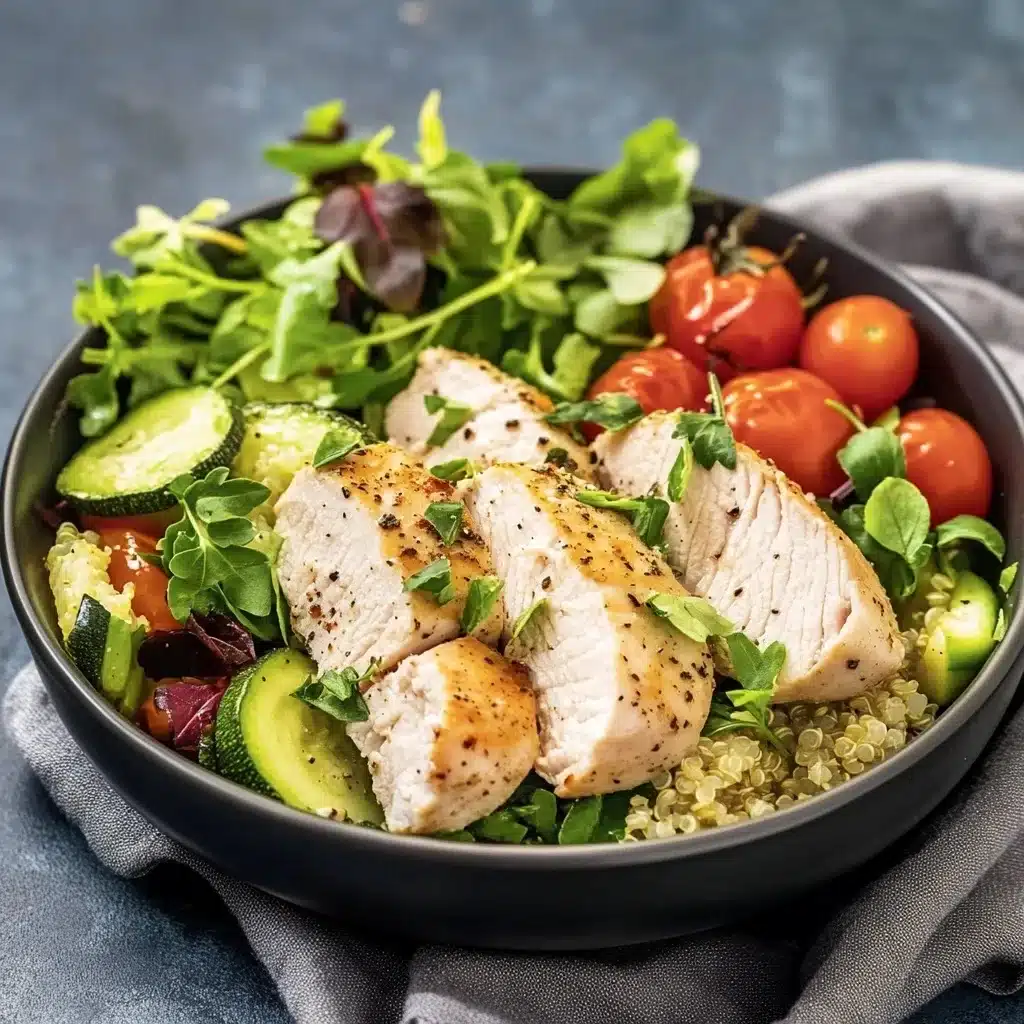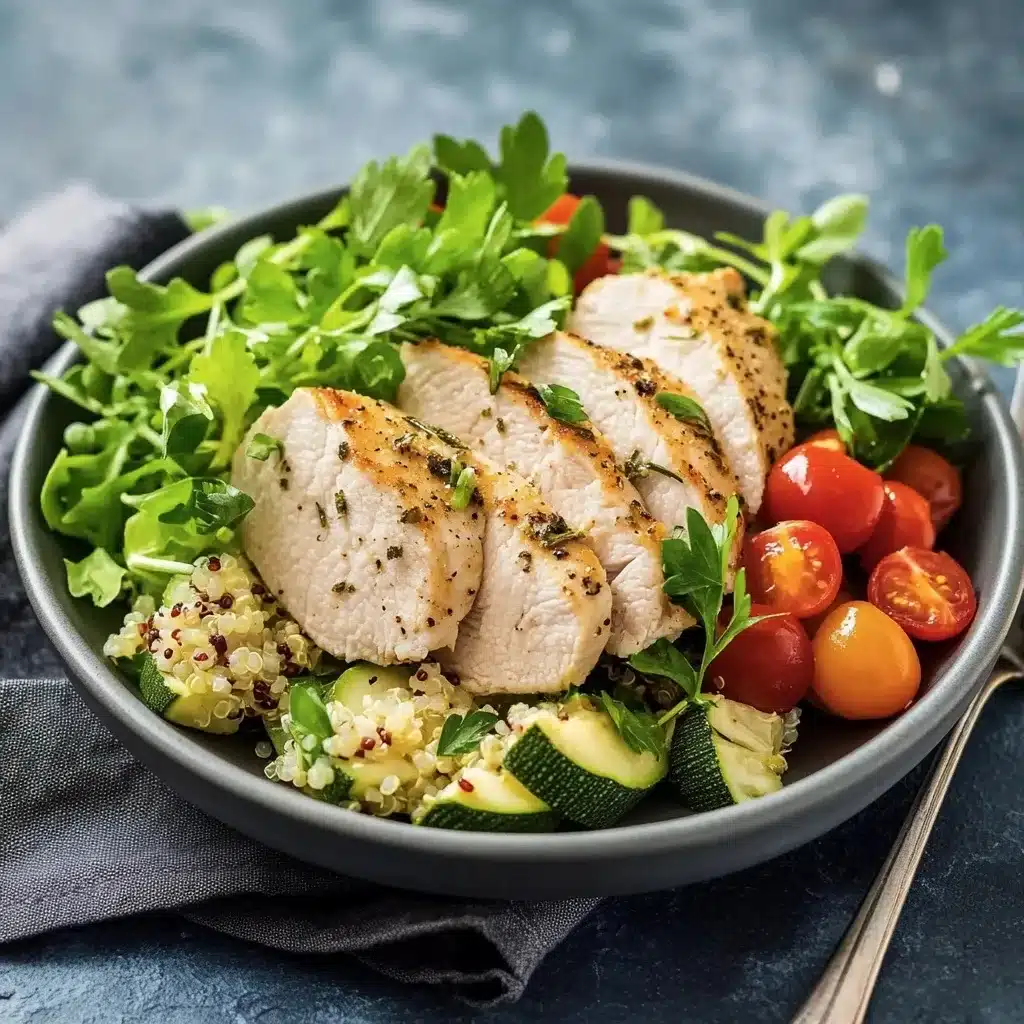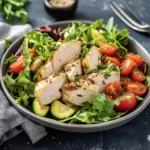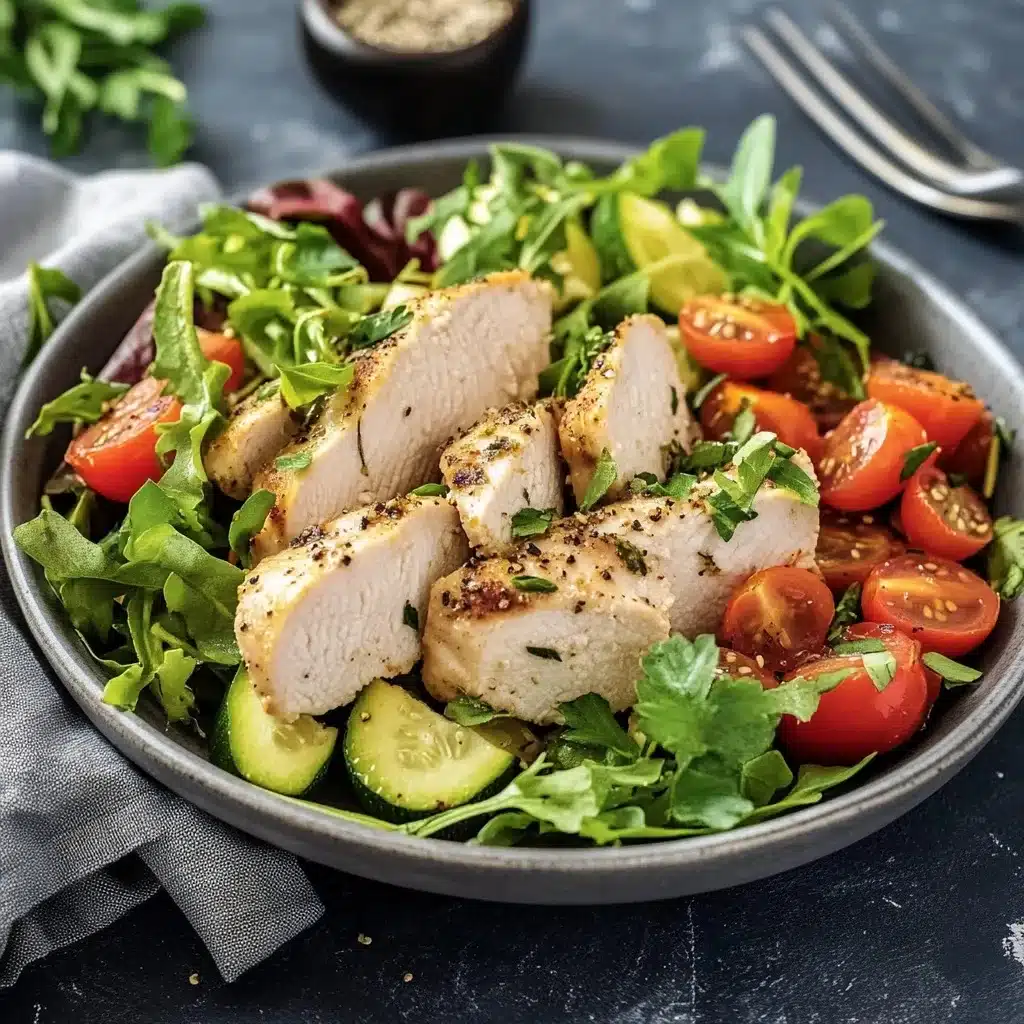There’s something deeply satisfying about a well-crafted meal that combines wholesome ingredients, vibrant flavors, and the kind of comfort that reminds you of home. Mama’s Savory Herb Chicken Bowls deliver exactly that – a perfect harmony of protein, vegetables, and grains that not only nourishes your body but also delights your taste buds. Whether you’re meal prepping for a busy week ahead or serving up a cozy family dinner, these herb chicken bowls are destined to become a household favorite.
What sets these herb chicken bowls apart is their incredible versatility and the perfect balance of flavors. The chicken is marinated in a savory blend of herbs and spices, creating tender, juicy meat that serves as the star of the show. Paired with roasted vegetables and your choice of quinoa or cauliflower rice, these bowls offer a complete meal that’s as nutritious as it is delicious.
In this comprehensive guide, we’ll walk through everything you need to know to create perfect herb chicken bowls, from selecting the finest ingredients to meal prep strategies that will save you time and energy throughout your week. Let’s dive in and discover why these bowls deserve a permanent spot in your recipe collection!
The Magic Behind Herb Chicken Bowls
The concept of “bowl food” has gained tremendous popularity in recent years, and for good reason. These herb chicken bowls represent the best of this trend – combining protein, vegetables, and grains in a single vessel that makes for convenient eating and beautiful presentation. The bowl format allows each component to maintain its individual flavor while also letting the ingredients mingle together in delightful ways.
The star of these herb chicken bowls is, of course, the perfectly marinated chicken. The combination of Dijon mustard, apple cider vinegar, and a thoughtfully selected blend of herbs and spices creates chicken that’s anything but bland. The marinade not only infuses the meat with flavor but also helps keep it incredibly tender and juicy through the cooking process.
What makes these herb chicken bowls truly special is their adaptability to your lifestyle. For busy professionals, they offer an ideal meal prep solution – components can be prepared in advance and assembled quickly throughout the week. For families, they provide a nutritious dinner option that can be customized to please even picky eaters. And for health-conscious individuals, these bowls deliver a balanced meal with lean protein, vegetables, and complex carbohydrates or low-carb alternatives.
The beauty of herb chicken bowls also lies in their nutritional profile. Chicken breast provides lean protein essential for muscle maintenance and satiety. The vegetables contribute vital vitamins, minerals, and fiber. And depending on your dietary needs, you can opt for quinoa’s protein-packed goodness or cauliflower rice’s low-carb benefits. It’s truly a win-win situation for your taste buds and your health!
Essential Ingredients for Perfect Herb Chicken Bowls
The Protein Base
The foundation of exceptional herb chicken bowls starts with quality chicken. While any boneless, skinless chicken breasts will work, opting for organic chicken can elevate the dish with better flavor and nutritional value. Organic chicken tends to have a better taste profile as the birds are raised without antibiotics and with access to more natural diets.
When selecting chicken for your herb chicken bowls, look for pieces that are roughly the same size to ensure even cooking. If the breasts are particularly thick, consider butterflying them or pounding them to a more uniform thickness, which helps them cook more evenly and absorb more of the marinade’s flavor.
For a leaner option, chicken tenders can be substituted and will cook more quickly. If you prefer darker meat, boneless, skinless chicken thighs make an excellent alternative, offering more flavor and moisture, though they’ll need slightly longer cooking times for your herb chicken bowls.
The Marinade Magic
The marinade is what transforms ordinary chicken into the flavorful centerpiece of your herb chicken bowls. Each component plays a specific role:
- Olive oil serves as the base, helping to distribute flavors and prevent the chicken from sticking during cooking.
- Apple cider vinegar tenderizes the meat while adding a subtle tangy note.
- Dijon mustard acts as an emulsifier for the marinade while contributing complexity and depth.
- Garlic and onion powders provide aromatic foundation notes without the texture of fresh garlic and onion.
- Dried thyme brings a classic, earthy herbal quality that pairs beautifully with chicken.
- Smoked paprika adds a subtle smokiness and beautiful color.
For the best results in your herb chicken bowls, allow the chicken to marinate for at least 30 minutes, but don’t hesitate to prepare this the night before for even more developed flavors. The longer marinade time allows the acids to tenderize the meat and for the flavors to penetrate more deeply.
Vegetable Components
The vegetables in herb chicken bowls add color, texture, nutrients, and flavor contrast. Zucchini and cherry tomatoes are specified in the recipe, but this is where you can get creative based on seasonal availability or personal preference:
- Zucchini absorbs flavors well and develops a lovely sweetness when roasted.
- Cherry tomatoes burst with juicy flavor and caramelize beautifully in the oven.
Other excellent vegetable options for your herb chicken bowls include:
- Bell peppers (any color) for sweetness and vitamin C
- Broccoli florets for texture and nutritional punch
- Red onion for aromatic depth
- Asparagus spears in the spring
- Butternut squash cubes in the fall
The key to perfect vegetables in herb chicken bowls is not overcrowding the roasting pan, which could cause steaming rather than roasting. Arrange vegetables in a single layer and give them space to allow proper caramelization.
Grain Foundations
The base of your herb chicken bowls provides satisfying substance and helps absorb the delicious juices from the chicken and vegetables. Quinoa makes an excellent choice with its complete protein profile and nutty flavor. For best results, rinse quinoa thoroughly before cooking to remove its natural bitter coating.
Cauliflower rice offers a lower-carb alternative that’s becoming increasingly popular in herb chicken bowls. It can be purchased pre-riced or easily made at home by pulsing cauliflower florets in a food processor until they reach a rice-like consistency.
Other excellent bases for herb chicken bowls include:
- Brown rice for a heartier texture
- Farro or barley for a chewy, nutty profile
- Mixed greens for an ultra-light option
- Couscous for quick-cooking convenience

Mastering the Preparation Process
The Perfect Marinade Technique
Creating exceptional herb chicken bowls begins with properly marinating the chicken. Start by combining all marinade ingredients in a bowl large enough to accommodate the chicken. Whisk thoroughly to emulsify the oil, vinegar, and mustard, creating a uniform mixture that will coat the chicken evenly.
When adding the chicken to the marinade, ensure each piece is fully submerged or coated on all sides. If using a zip-top bag (ideal for herb chicken bowls meal prep), press out excess air before sealing to maximize contact between the chicken and marinade. Massage the bag gently to distribute the marinade evenly around each piece.
For food safety, always marinate chicken in the refrigerator, never at room temperature. If you’re planning ahead for your herb chicken bowls, you can freeze the chicken in its marinade – this not only saves time later but also allows the marinade flavors to penetrate the meat as it thaws.
Searing and Roasting for Maximum Flavor
The two-step cooking method of searing then roasting is crucial for developing the best flavor and texture in herb chicken bowls. The initial sear in a hot skillet creates a flavorful crust through the Maillard reaction – a complex chemical process that produces hundreds of flavor compounds. This step locks in juices and creates the foundation for truly delicious herb chicken bowls.
For the perfect sear, ensure your skillet is properly heated before adding the chicken. The pan should be hot enough that a drop of water sizzles instantly when it hits the surface. Place the marinated chicken in the pan without overcrowding and resist the urge to move it for at least two minutes, allowing that beautiful golden crust to form.
Transferring to the oven for the remainder of cooking ensures the chicken cooks through evenly without burning the exterior. This gentle heat allows the chicken to reach the food-safe internal temperature of 165°F while remaining juicy – critical for perfect herb chicken bowls.
Vegetable Roasting Fundamentals
The roasted vegetables add essential flavor, texture, and nutritional value to herb chicken bowls. For the best results, cut vegetables into uniform pieces to ensure even cooking. The ideal size for most vegetables in herb chicken bowls is about 1-inch pieces, which allow for proper caramelization while maintaining some textural integrity.
Proper seasoning is simple but crucial – a light coating of olive oil helps the vegetables roast rather than steam, while salt and pepper enhance their natural flavors. For herb chicken bowls with a cohesive flavor profile, consider adding a light sprinkle of the same herbs used in the chicken marinade to your vegetables.
Arrange vegetables in a single layer on a baking sheet, ensuring they’re not touching or overcrowded. This allows hot air to circulate around each piece, promoting caramelization rather than steaming. For herb chicken bowls with perfectly roasted vegetables, give the pan a shake or stir halfway through cooking to promote even browning.
Bowl Assembly Strategy
The assembly of herb chicken bowls is both practical and artistic. Start with the grain base, creating a foundation that will absorb the flavorful juices from the other components. Aim for about ½ cup of quinoa or cauliflower rice per serving – enough to provide substance without overwhelming the other elements of your herb chicken bowls.
Slice the chicken against the grain into ¼-inch pieces, which ensures maximum tenderness when eating. Allowing the chicken to rest for 5-10 minutes before slicing is crucial for herb chicken bowls, as it gives the juices time to redistribute throughout the meat.
Arrange the components in a visually appealing way, placing the sliced chicken and roasted vegetables atop the grain base in separate sections. This not only creates a more attractive presentation for your herb chicken bowls but also allows each person to mix the components according to their preference while eating.
A final sprinkle of fresh herbs adds color, aroma, and a brightness that balances the savory, roasted elements of herb chicken bowls. Don’t skip this finishing touch, as it elevates the entire eating experience.
Mama’s Savory Herb Chicken Bowls: Complete Recipe
Ingredients
For the Chicken:
- 1.5 pounds boneless, skinless chicken breasts (organic if possible)
- 2 tablespoons olive oil
- 1 tablespoon apple cider vinegar
- 1 tablespoon Dijon mustard
- 1 teaspoon garlic powder
- 1 teaspoon onion powder
- 1 teaspoon dried thyme
- ½ teaspoon smoked paprika
- Salt and pepper to taste
For the Bowls:
- 1 medium zucchini, chopped
- 1 cup cherry tomatoes, halved
- 1 tablespoon olive oil (for vegetables)
- 1 cup cooked quinoa or cauliflower rice
- Fresh parsley for garnish (optional)
Equipment Needed
- Mixing bowl or zip-top bag for marinating
- Cast iron or oven-safe skillet
- Baking sheet for vegetables
- Meat thermometer
- Cutting board and sharp knife
- Measuring spoons and cups
Step-by-Step Instructions
- Marinate the Chicken: In a bowl or zip-top bag, combine olive oil, apple cider vinegar, Dijon mustard, garlic powder, onion powder, dried thyme, smoked paprika, salt, and pepper. Add chicken breasts and ensure they’re well-coated. Refrigerate for at least 30 minutes, or overnight for more developed flavor in your herb chicken bowls.
- Preheat and Prepare: Preheat your oven to 400°F. While heating, remove the marinated chicken from the refrigerator and let it come to room temperature for about 15 minutes for more even cooking.
- Sear the Chicken: Heat a cast iron or oven-safe skillet over medium-high heat. Once hot, add the marinated chicken breasts and sear for approximately 2 minutes on each side until golden brown.
- Finish in Oven: Transfer the skillet with chicken to the preheated oven and roast for 18-20 minutes, or until the internal temperature reaches 165°F and juices run clear.
- Prepare Vegetables: While the chicken cooks, spread chopped zucchini and halved cherry tomatoes on a baking sheet. Drizzle with olive oil, season with salt and pepper, and toss to coat. Place in the oven alongside the chicken for the final 15-18 minutes of cooking time.
- Rest the Chicken: Once cooked, remove the chicken from the oven and let it rest for 5-10 minutes before slicing. This helps retain moisture for perfect herb chicken bowls.
- Assemble Bowls: Place approximately ½ cup of cooked quinoa or cauliflower rice in each bowl. Slice the chicken against the grain and arrange on top of the grain base. Add the roasted vegetables alongside the chicken.
- Finish and Serve: Garnish your herb chicken bowls with fresh parsley if desired. Serve immediately or portion into containers for meal prep.

Expert Tips for Perfect Herb Chicken Bowls
Common Mistakes to Avoid
Even simple recipes like herb chicken bowls have potential pitfalls. Avoid these common mistakes to ensure delicious results every time:
Overcooking the chicken is perhaps the most common error when preparing herb chicken bowls. Chicken breast can quickly go from juicy to dry if cooked too long. Invest in an instant-read thermometer and remove the chicken from heat when it reaches 160°F – it will continue cooking to the safe temperature of 165°F during resting.
Skipping the marinating time significantly reduces flavor development in herb chicken bowls. If you’re truly pressed for time, even 15 minutes of marinating will make a difference, but try to plan for at least 30 minutes.
Overcrowding the vegetables on the baking sheet leads to steaming rather than roasting, resulting in soggy rather than caramelized vegetables for your herb chicken bowls. Use two baking sheets if necessary to give vegetables proper space.
Not allowing the chicken to rest before slicing causes the juices to run out onto the cutting board rather than remaining in the meat. This crucial step makes all the difference in creating moist, flavorful herb chicken bowls.
Variations to Try
The basic herb chicken bowls recipe provides a wonderful template that can be adapted in countless ways:
Mediterranean Herb Chicken Bowls: Add olives, feta cheese, and cucumber to the bowl, and incorporate oregano and lemon zest into the chicken marinade.
Southwest Herb Chicken Bowls: Use black beans, corn, and avocado as toppings, and add cumin and chili powder to the chicken marinade.
Asian-Inspired Herb Chicken Bowls: Top with edamame, shredded carrot, and sliced cucumber. Modify the marinade with soy sauce, ginger, and a touch of honey.
Autumn Herb Chicken Bowls: Substitute sweet potatoes and Brussels sprouts for the zucchini and tomatoes, and add rosemary to the herb blend.
These variations keep herb chicken bowls exciting and allow you to adapt the concept to seasonal ingredients and different flavor preferences.
Meal Prep Strategies for Herb Chicken Bowls
One of the greatest advantages of herb chicken bowls is their suitability for meal preparation. With some strategic planning, you can enjoy these nutritious, flavorful meals throughout the week with minimal daily effort.
For the most efficient herb chicken bowls meal prep, consider cooking components in larger batches. Double or triple the chicken recipe, roast extra vegetables, and prepare a bigger batch of quinoa or cauliflower rice. These components can then be mixed and matched throughout the week.
Store prepared herb chicken bowls components in separate containers in the refrigerator for maximum freshness and texture. The chicken will maintain quality for 3-4 days, roasted vegetables for 4-5 days, and cooked quinoa for up to 5 days. Cauliflower rice is best when used within 2-3 days.
When assembling herb chicken bowls for future meals, consider keeping the components separate until ready to eat, especially if you plan to heat the meal. This prevents the vegetables from becoming overcooked and the grains from drying out.
For variety in your herb chicken bowls throughout the week, prepare different sauces or toppings to change the flavor profile. A simple yogurt-based sauce, tahini dressing, or salsa can transform the same basic components into what feels like an entirely new meal.
Nutritional Benefits of Herb Chicken Bowls
These herb chicken bowls aren’t just delicious – they’re nutritional powerhouses that provide a balanced meal in a single dish.
The chicken in herb chicken bowls delivers high-quality protein essential for muscle maintenance and satiety. A typical serving provides approximately 25-30 grams of protein, helping to keep you feeling full longer and supporting muscle recovery after exercise.
The vegetables contribute vital vitamins, minerals, and fiber. Zucchini is rich in manganese, vitamin C, and antioxidants, while cherry tomatoes provide lycopene, potassium, and folate. Together, they add volume and nutrients to herb chicken bowls without excessive calories.
Quinoa elevates herb chicken bowls with its impressive nutritional profile as one of the few plant sources of complete protein. It also provides fiber, magnesium, B vitamins, iron, potassium, calcium, phosphorus, and vitamin E. For those following lower-carb diets, cauliflower rice offers vitamin C, vitamin K, and cancer-fighting glucosinolates.
The olive oil and herbs in herb chicken bowls contribute antioxidants and anti-inflammatory compounds. Thyme, in particular, contains thymol, which has antimicrobial properties, while olive oil provides heart-healthy monounsaturated fats.
Overall, a serving of these herb chicken bowls provides a balanced macronutrient profile with approximately 400-450 calories, 30g protein, 40g carbohydrates (less with cauliflower rice), and 15g healthy fats – a perfect combination for sustained energy and satisfaction.

Serving Suggestions for Herb Chicken Bowls
While herb chicken bowls are a complete meal on their own, you can enhance the experience with thoughtful accompaniments and presentation.
For family-style serving of herb chicken bowls, consider setting up a “bowl bar” with all components arranged separately, allowing each person to build their own bowl according to preference. This is especially helpful for households with varying dietary needs or picky eaters.
A simple side salad with a light vinaigrette complements herb chicken bowls beautifully, adding fresh, crisp textures that contrast with the roasted elements of the main dish.
For special occasions, consider elevating your herb chicken bowls with premium additions like toasted pine nuts, pomegranate seeds, or a drizzle of high-quality flavored olive oil.
Beverage pairings can enhance herb chicken bowls as well. A crisp white wine, light beer, sparkling water with citrus, or iced herb tea all complement the flavors without overwhelming them.
Frequently Asked Questions About Herb Chicken Bowls
Can I use chicken thighs instead of breasts for herb chicken bowls? Absolutely! Boneless, skinless chicken thighs work beautifully in herb chicken bowls, offering more flavor and moisture tolerance. Simply adjust the cooking time – thighs typically need about 5-7 minutes longer in the oven than breasts.
How far in advance can I prepare herb chicken bowls for meal prep? The components of herb chicken bowls can be prepared 3-4 days in advance and assembled daily. For best results, store components separately and combine just before eating.
Are herb chicken bowls freezer-friendly? Yes, with some adjustments. The marinated raw chicken freezes exceptionally well for up to 3 months. Cooked chicken and quinoa can be frozen for 2-3 months. Fresh vegetables are best prepared fresh rather than frozen, though roasted vegetables can be frozen for up to 1 month. Assemble your herb chicken bowls after thawing the components.
Can herb chicken bowls be made vegetarian? Certainly! Replace the chicken with firm tofu, tempeh, or chickpeas using the same marinade for plant-based herb chicken bowls. Adjust cooking times accordingly – tofu typically needs about 25-30 minutes in the oven after a brief sear.
What’s the best way to reheat herb chicken bowls without drying out the chicken? For the best reheated herb chicken bowls, add a tablespoon of water or broth before microwaving on 70% power, covered with a damp paper towel. Alternatively, reheat in a 325°F oven, covered, until just warmed through. Avoid high heat, which can toughen the chicken.
Why Herb Chicken Bowls Will Become Your New Favorite
There’s a reason dishes like these herb chicken bowls become staples in home kitchens – they strike that perfect balance between flavor, nutrition, and convenience that makes everyday cooking a joy rather than a chore. The combination of juicy marinated chicken, caramelized roasted vegetables, and satisfying grains creates a meal that feels simultaneously special and accessible.
What makes herb chicken bowls particularly valuable is their adaptability to your life. They can be an impressive dinner for guests, a reliable meal prep solution for busy weeks, or a family-friendly dinner that satisfies diverse palates. And with countless variations possible, herb chicken bowls can evolve with your preferences and the changing seasons.
We encourage you to make this recipe your own. Experiment with different vegetables, try various herbs in the marinade, or swap in your favorite grain base. The fundamental techniques will serve you well regardless of the specific ingredients you choose. And don’t forget to share your herb chicken bowls creations with others – good food is always better when shared!
More Related Recipes You Might Enjoy
If you’ve fallen in love with these herb chicken bowls, you’ll definitely want to explore these related recipes that share similar preparation methods, flavors, or meal prep convenience:
- Summer Berry Meal Prep – A perfect complement to your herb chicken bowls for a complete week of prepared meals
- Summer Clean Meal Prep Bowls – Another bowl-based meal prep option with fresh, clean flavors
- Summer Lemon Herb Chicken Veggie Bowls – A citrus-forward variation on herb chicken bowls perfect for warmer months
These recipes share the fundamental approach of herb chicken bowls – thoughtful preparation of individual components that come together in balanced, flavorful meals designed for both enjoyment and nourishment. By mastering these recipes, you’ll develop versatile cooking skills that will serve you well in countless kitchen endeavors.
Print
Herb Chicken Bowls: 7 Incredible Secrets for Ultimate Meal Prep
- Total Time: 40 minutes (plus marinating time)
- Yield: 4 servings 1x
- Diet: Low Calorie
Description
Mama’s Savory Herb Chicken Bowls combine perfectly seasoned chicken breast with fresh vegetables and your choice of quinoa or cauliflower rice for a balanced, flavorful meal. Ideal for meal prep or family dinners, these bowls feature a delicious herb marinade that transforms ordinary chicken into a mouthwatering centerpiece for a nutritious and satisfying dish.
Ingredients
- 1.5 pounds boneless, skinless chicken breasts (organic if possible)
- 2 tablespoons olive oil
- 1 tablespoon apple cider vinegar
- 1 tablespoon Dijon mustard
- 1 teaspoon garlic powder
- 1 teaspoon onion powder
- 1 teaspoon dried thyme
- ½ teaspoon smoked paprika
- Salt and pepper to taste
- 1 medium zucchini, chopped
- 1 cup cherry tomatoes, halved
- 1 tablespoon olive oil (for vegetables)
- 1 cup cooked quinoa or cauliflower rice
- Fresh parsley for garnish (optional)
Instructions
- In a bowl or zip-top bag, mix olive oil, apple cider vinegar, Dijon mustard, garlic powder, onion powder, dried thyme, smoked paprika, salt, and pepper. Add chicken breasts and coat well. Marinate in the refrigerator for at least 30 minutes, preferably overnight.
- Preheat your oven to 400°F. Remove the marinated chicken from the refrigerator and let it come to room temperature for about 15 minutes.
- Heat a cast iron or oven-safe skillet over medium-high heat. Sear the marinated chicken breasts for approximately 2 minutes on each side until golden brown.
- Transfer the skillet with chicken to the preheated oven and roast for 18-20 minutes, or until the internal temperature reaches 165°F and juices run clear.
- While the chicken cooks, spread chopped zucchini and halved cherry tomatoes on a baking sheet. Drizzle with olive oil, season with salt and pepper, and toss to coat. Place in the oven alongside the chicken for the final 15-18 minutes of cooking time.
- Once cooked, remove the chicken from the oven and let it rest for 5-10 minutes before slicing.
- Place approximately ½ cup of cooked quinoa or cauliflower rice in each bowl. Slice the chicken against the grain and arrange on top of the grain base. Add the roasted vegetables alongside the chicken.
- Garnish with fresh parsley if desired and serve immediately, or portion into containers for meal prep.
Notes
- For meal prep: Store components separately in the refrigerator for best results. The chicken will maintain quality for 3-4 days, roasted vegetables for 4-5 days, and cooked quinoa for up to 5 days.
- Customize with your favorite vegetables based on seasonal availability.
- For a lower-carb option, substitute cauliflower rice for quinoa.
- The chicken marinade can be prepared up to 2 days in advance and stored in the refrigerator.
- For extra flavor, add a squeeze of fresh lemon juice just before serving.
- Prep Time: 15 minutes (plus marinating time)
- Cook Time: 25 minutes
- Category: Main Dish
- Method: Baking
- Cuisine: American
Nutrition
- Serving Size: 1 bowl
- Calories: 320
- Sugar: 2g
- Sodium: 310mg
- Fat: 12g
- Saturated Fat: 2g
- Unsaturated Fat: 9g
- Trans Fat: 0g
- Carbohydrates: 18g
- Fiber: 3g
- Protein: 32g
- Cholesterol: 85mg

